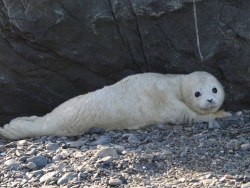Primorsky Aquarium expert studies spotted seal populations in the Peter the Great Bay

On March 29 Igor Katin, Principal Specialist of the Marine Mammal Research Station, Primorsky Aquarium, and Researcher at the National Scientific Center of Marine Biology, took to the Verkhovsky Islands together with a team of scientists. Their main goal is to monitor the population of the spotted, or largha, seal (Phoca largha).
The Verkhovsky Islands are located in the western Peter the Great Bay, Sea of Japan, and are part of the Far-Eastern Marine Reserve. The largha seal is the only marine mammal species reproducing in the marine reserve. It should be noted that, although spotted seals are generally ice-breeding, i.e. they haul out on ice floes for breeding, the larghas in the Peter the Great Bay choose the shores of islands during this season.
As Igor Katin says, the population has been constantly monitored for several decades. Researchers usually record the main characteristics of the stock: the distribution of seals on haul-out sites and their behavior, the composition of the population, its size and age-sex structure.
The main type of data collected in spring is the birth rate, particularly the count of births during the whelping season, which lasts from January to April.
Females always give birth to one pup. They produce thick, fat-rich milk and pups rapidly gain weight, 2 kg a day. At birth, largha seals weigh about 8 kg. After three to four weeks of nursing, they grow up to 40 kg.
Pups are born with a white natal coat, which is shed during their first molt, two to four weeks later, when they become adult color.
Animal counts are conducted from boats and from the ground (by walking along the rookeries), by use of photo- and video-cameras.
Several years ago, new technologies, automated timelapse cameras and unmanned aerial vehicles (UAVs), emerged. They have improved the precision and accuracy of the data collected while monitoring the seals’ population. These technologies have also been used to detect ghost nets and other fishing gear that can injure and kill animals on rookeries.